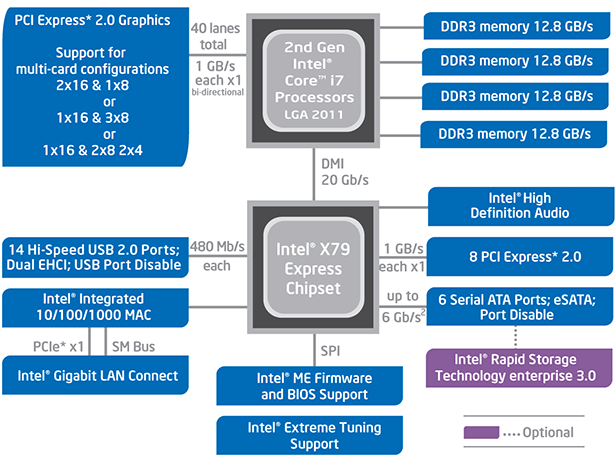Intel Core i7-3960X Extreme Edition Sandy Bridge-E CPU
The X79 Express and Intel DX79SI
Arriving alongside the new Sandy Bridge-E based Core i7 desktop processors is Intel’s X79 Express chipset. Below is a high-level block diagram of the X79 Express chipset, which is targeted at the high-performance and enthusiast market segments.

Intel X79 Express Chipset Block Diagram
Like most recent chipsets for Intel’s current processors, the X79 Express is essentially an I/O hub, as all of the traditional Northbridge functionality is integrated into the processor itself. As you can see, LGA2011 Sandy Bridge-E processors offer a whopping 40 lanes of PCI Express connectivity and feature an integrated quad-channel DDR3 memory controller. The PCIe links can be arranged in any number of configurations, and although they’re listed as PCI Express 2.0 here, these integrated PCI Express lanes actually support PCI Express 3.0 speeds. We’re told the lack of PCI Express 3.0 GPUs and peripherals at this time have prevented Intel from definitively qualifying the Sandy Bridge-E’s integrated PCI Express lanes as PCI Express 3.0 capable, so they’re not being labeled as such. However, the functionality does exist, once testing and qualification is complete.
The processors are linked to the chipset via a 20Gb/s interface (DMI) and the X79 Express is outfitted with 8 more PCIe 2.0 lanes, along with various other I/O options, like USB 2.0 (14 ports), six SATA ports (2 x SATA III), an integrated Gigabit MAC, HD audio, etc. We should point out that the X79 Express has native support for SATA 6Gbs on two of its ports, but not USB 3.0. USB 3.0 is only available through the use of third-party controllers like those from VIA, Reneasas / NEC, or ASMedia.

Intel DX79SI "Siler" X79 Express-Based Motherboard
To showcase the X79 Express chipset, Intel has designed and built a high-end motherboard dubbed the DX79SI (codename: Siler). The DX79SI exploits all of the features inherent to the X79 Express chipset and adds a few more, like USB 3.0 and Firewire, through the use of third-party controllers. The board features “BIOS Vault” technology, which essentially acts as a backup BIOS / UEFI in the event of a bad flash or malware attack. It also features Intel’s “Fast Boot” technology, which speeds the boot process by eliminating the need to complete a full POST when the hardware and configuration of the system is unchanged from the previous boot. The DX79SI also supports Extreme Memory Profiles (XMP) for easy high-speed memory configuration and even includes an extensive set of overclocking tools. And those tools are not only available via the BIOS / UEFI, but also through a Windows-based application called the Intel Extreme Tuning Utility, or Intel XTU. XTU gives users the ability to tweak numerous performance-related options and monitors system temperatures and fan speeds. “One Touch” overclocking options are also available for those that want a quick and easy speed boost, without doing much tweaking.
The DX79SI uses the same black and blue color scheme of many previous enthusiast-class Intel-built motherboards and it features heavy-duty heatsinks for the chipset and voltage regulation modules. In addition, the DX79SI offers four SuperSpeed USB 3.0 ports, two IEEE 1394a ports (1 external, 1 via internal header), and 14 USB 2.0 ports (6 external ports in the IO backplane, 8 via internal headers). The board also sports a couple of integrated power and reset switches, solid capacitors, and a POST code error reporter, along with a number of LED status indicators. Finally, the board is outfitted with three PCI Express x16 slots, with full support for both NVIDIA’s SLI and AMD’s CrossFire multi-GPU technologies.









